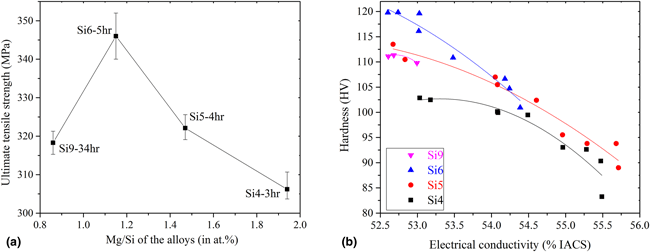Crossref Citations
This article has been cited by the following publications. This list is generated based on data provided by
Crossref.
Khangholi, Siamak Nikzad
Javidani, Mousa
Maltais, Alexandre
and
Chen, X.-Grant
2021.
Effects of natural aging and pre-aging on the strength and electrical conductivity in Al-Mg-Si AA6201 conductor alloys.
Materials Science and Engineering: A,
Vol. 820,
Issue. ,
p.
141538.
Zheng, QiuJu
Jiang, HongXiang
He, Jie
Zhang, LiLi
and
Zhao, JiuZhou
2021.
Effect of micro-alloying La on precipitation behavior, mechanical properties and electrical conductivity of Al-Mg-Si alloys.
Science China Technological Sciences,
Vol. 64,
Issue. 9,
p.
2012.
Khangholi, Siamak Nikzad
Javidani, Mousa
Maltais, Alexandre
and
Chen, X.-Grant
2022.
Effect of Ag and Cu addition on the strength and electrical conductivity of Al-Mg-Si alloys using conventional and modified thermomechanical treatments.
Journal of Alloys and Compounds,
Vol. 914,
Issue. ,
p.
165242.
Huang, Jiajun
Zhou, Xiong
Guo, Jialin
Liao, Hengbin
and
Du, Jun
2022.
Effect of Ni Addition on the Microstructure and Mechanical Properties of 6101 Aluminum Alloy with High Electrical Conductivity.
Journal of Materials Engineering and Performance,
Vol. 31,
Issue. 11,
p.
8923.
Khangholi, Siamak Nikzad
Javidani, Mousa
Maltais, Alexandre
and
Chen, X. Grant
2022.
Review on recent progress in Al–Mg–Si 6xxx conductor alloys.
Journal of Materials Research,
Vol. 37,
Issue. 3,
p.
670.
Jiang, Hongxiang
Zheng, Qiuju
Song, Yan
Li, Yanqiang
Li, Shixin
He, Jie
Zhang, Lili
and
Zhao, Jiuzhou
2022.
Influence of minor La addition on the solidification, aging behaviors and the tensile properties of Al-Mg-Si alloys.
Materials Characterization,
Vol. 185,
Issue. ,
p.
111750.
Khangholi, Siamak Nikzad
Javidani, Mousa
Maltais, Alexandre
and
Chen, X. Grant
2023.
Proceedings of the 61st Conference of Metallurgists, COM 2022.
p.
269.
Allamki, Alyaqadhan
Al-Maharbi, Majid
Qamar, Sayyad Zahid
and
Al-Jahwari, Farooq
2023.
Precipitation Hardening of the Electrical Conductor Aluminum Alloy 6201.
Metals,
Vol. 13,
Issue. 6,
p.
1111.
Khoshghadam-Pireyousefan, Mohammad
Javidani, Mousa
Maltais, Alexandre
Lévesque, Julie
and
Chen, X.-Grant
2023.
Effect of Annealing Temperature on the Microstructure, Mechanical Properties, and Electrical Conductivity of 4xxx Series Al-Based Alloys.
p.
14.
Wang, Yu
Zhu, Langjie
and
Mao, Jian
2023.
High-Strength Conductive Al-0.5 Mg-1.0Si Alloys Modified by Ce and Cu.
Journal of Materials Engineering and Performance,
Vol. 32,
Issue. 3,
p.
1357.
Li, Xiang
Li, Hongying
Tang, Haoqing
Xiao, Xiang
Han, Jiaqiang
and
Zheng, Ziqiao
2023.
Microstructure Evolution and In Situ Resistivity Response of 2196 Al-Li Alloy during Aging Process.
Materials,
Vol. 16,
Issue. 23,
p.
7492.
Lawalin, Josh
Gauthier, Pascal
and
Wang, Tao
2023.
Light Metals 2023.
p.
253.
Nokhrin, Aleksey V.
Nagicheva, Galina S.
Chuvil’deev, Vladimir N.
Kopylov, Vladimir I.
Bobrov, Aleksandr A.
and
Tabachkova, Nataliya Yu.
2023.
Effect of Er, Si, Hf and Nb Additives on the Thermal Stability of Microstructure, Electrical Resistivity and Microhardness of Fine-Grained Aluminum Alloys of Al-0.25%Zr.
Materials,
Vol. 16,
Issue. 5,
p.
2114.
Cui, Xiaoli
Ye, Hui
Liu, Houyun
Li, Xinghui
Man, Qianming
Li, Hui
Cui, Hongwei
Feng, Rui
and
Pan, Yaokun
2023.
The improvement mechanism of good matching between electrical conductivity and mechanical properties for Al-4Si-0.8Mg-0.6Fe alloy.
Journal of Alloys and Compounds,
Vol. 938,
Issue. ,
p.
168275.
Khangholi, Siamak Nikzad
Javidani, Mousa
Maltais, Alexandre
and
Chen, X.-Grant
2024.
Novel approach to high-strength, highly conductive Al-Mg-Si conductor alloys with Ag/Cu additions.
Materials Today Communications,
Vol. 39,
Issue. ,
p.
108921.
Algendy, Ahmed Y.
Javidani, Mousa
Khangholi, Siamak Nikzad
Pan, Lei
and
Chen, X.-Grant
2024.
Enhanced Mechanical Strength and Electrical Conductivity of Al–Ni‐Based Conductor Cast Alloys Containing Mg and Si.
Advanced Engineering Materials,
Vol. 26,
Issue. 1,
Mao, Qingzhong
Wang, Long
Nie, Jinfeng
and
Zhao, Yonghao
2024.
Optimizing strength and electrical conductivity of 6201 aluminum alloy wire through rotary swaging and aging processes.
Journal of Materials Processing Technology,
Vol. 331,
Issue. ,
p.
118497.
Khoshghadam-Pireyousefan, Mohammad
Javidani, Mousa
Maltais, Alexandre
Lévesque, Julie
and
Chen, X.-Grant
2024.
Breaking the strength-conductivity paradigm in hypoeutectic Al–Si alloy via annealing-induced Si nanoprecipitation.
Materials Science and Engineering: A,
Vol. 911,
Issue. ,
p.
146924.
Czerwinski, Frank
2024.
Aluminum alloys for electrical engineering: a review.
Journal of Materials Science,
Vol. 59,
Issue. 32,
p.
14847.
Fu, Yu
Luo, Qun
Liu, Bin
and
Li, Qian
2024.
Viscosity Calculation for Al–Si–Mg–Fe System through CALPHAD Method.
Advanced Engineering Materials,
Vol. 26,
Issue. 20,




